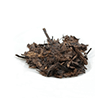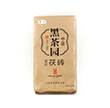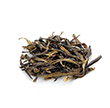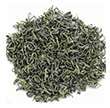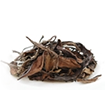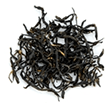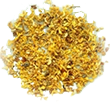About Oolong Tea
- Oxidization: Semi-oxidized
- Growing Regions: Fujian, Guangdong, Taiwan
- Best Seasons To Purchase: Spring and Autumn
- Pharmacological Elements: caffeine, flavonol, tea polyphenol, vitamin C and E, catechins, carotene and minerals such as zinc, selenium and florin

In the family tree of Chinese teas, Oolong Tea which is semi-oxidized, lies between un-oxidized Green Tea and oxidized Black Tea (called Black Tea in the West but actually known as Red Tea in China). The range of oxidization varies from 8% to 70%. Oolong is sometimes written as Wulong but the meaning is the same: Oo (Wu) means Black and Long means Dragon. Oolong Tea is also known in China as "Qing Cha".
According to the growing and processing region, there are four major categories of Oolong Tea :
- Northern Fujian Province: Wu Yi Tea (also called Cliff Tea or Rock Tea)
- Southern Fujian Province: Tie Guan Yin (also called Chinese Oolong, Iron Buddha, Buddha of Mercy, Gun Yam)
- Guangdong Province: Phoenix Oolong (also called Dan Chong Tea)
- Taiwan: Tung Ting, High Mountain, Alishan, Baojung
Production of Oolong Tea
Oolong Tea has 7 processing steps:
Withering
Picked leaves are spread out (inside and/or outside in the sun) to soften the cell walls of leaves. This draws the moisture to the surface for evaporation, softens the leaves, begins natural enzymatic oxidization and sets up the next stage of processing. This also reduces the grassy taste of tea leaves.
Tossing/Bruising (Turning Over)
Known as "Shaking" in Chinese, because in the old days, the leaves were simply shaken in a wicker basket. Today, this step is done with the aid of machines to further break down the leaves by mechanical means (as opposed to chemical means as in "Withering"). This improves oxidation and mixes chemical elements from the stems with the leaves, removing bitterness and balancing the flavour of the tea.
Oxidization (Partial and Full)
This step used in Oolongs and Black Teas continues the natural process of oxidization by allowing the leaves to rest after the Withering or Tossing/Bruising (Turning Over) steps. The time allowed determines the amount of oxidization for the tea being made. At this point, the leaves turn to a darker green or even a red colour, due to the breaking down of the cell structure of the leaves. It is at this stage where the tea begins to develop its grassy, flowery or fruity taste characteristics.
“Kill-Green” (also known as Fixing”)
Stops the natural oxidization and growing processes within the leaves without damaging them. Steaming the leaves, hand pressing in a hot pan and baking techniques are used. This also sets up the next step for Rolling/Forming the leaves.
Rolling/Forming
Leaves are passed through hot and/or cold rollers to slightly break down the leaves, which establishes the shape of the leaves and intensifies the tea flavour.
Drying
Establishes the final moisture content of the leaves, stops oxidization, prevents mold growth, removes any grassy leaf taste and develops the tea's aroma. Sun drying, pan heating and hot air methods are used.
Firing
Various methods of roasting in a pan or a basket with charcoal or electric heat are used to give a smoky flavour or a fruity characteristic.
A Quick History of Oolong Tea
Oolong Tea as we know it today is the result of a long evolution, originating during the Tang Dynasty (618 - 907) in the Beiyun region of Phoenix Mountain (Fenghuanshang) in Fujian Province. It was first known as Beiyun Tea and because of its fine quality and unique flavour, it was the first tea to be made a tribute tea, in the Song Dynasty (960-1279). In the tribute custom, tea regions were selected by the Emperor to produce tea to be offered as a gift to the royal court, which was a great honour and good for business.

In time, government officials, monks and scholars began visiting and emigrating to the Fujian area and were surprised with the strong “earth-stone” taste of the teas from the Wuyi Mountain region, so different from the un-oxidized Green Tea which was the only tea that existed in China to that point. These teas came to be known as Wuyi or Cliff Tea. Hearing of this wonderful new tea, the Emperor sent a sample of an un-oxidized compressed Green Tea cake to Wuyi and asked for tribute tea. What he received was Dragon Phoenix Compressed Tea which was made from a mold which imprinted the tea cake with the design of a dragon and a phoenix. This tea became very famous as a result.
The fame of Wuyi teas spread far and wide and continued to be designated as a tribute tea throughout the Ming (1368 - 1644) and Qing Dynasties (1644 - 1911).
In 1725, tea producers in the Anxi region of Fujian adapted the methods of making traditional Wuyi Tea and improved the technology to develop a new tea - Oolong. In 1796, Oolong Tea was introduced to the Northern Fujian region and to Taiwan, where today, each region is well known for their distinctive Oolong Teas.
Flavours of Oolong Tea
To learn about the flavours of Oolong Tea , see the Flavour Guide
Storing Oolong Tea
Because Oolong Tea is exposed to a small to medium amount of processing, the leaves are subject to natural enzymatic breakdown by oxidation just like any other organic material. Oolong Tea is best kept in a cool, dry place in an airtight container or even in a refrigerator. We recommend refrigeration which actually improves the taste of the tea, as well as making it last much longer. However, if refrigerated storage is used, the tea should be kept refrigerated at all times as successive warming and cooling will degrade the tea.
Oolong Tea And Health Benefits

There are many health benefits attributed to drinking Chinese tea, ranging from feelings of well-being to near magical cures. For the average Westerner, much of this interest is focused on ancient claims related to weight loss and more modern claims of cancer-prevention due to tea's anti-oxidant properties. Each person must make their own assessment of the facts. While there are centuries of tradition and empirical evidence from Traditional Chinese Medicine, there is little modern scientific consensus that supports the health benefits of tea. Even the effect of anti-oxidants to prevent anything has recently been drawn sharply into focus.
We believe that any food product can have positive and/or negative health effects and in varying degrees for different individuals. We do not recommend teas on the basis of health benefits and at this point, do not think it is prudent to recommend tea-drinking for anything other than to enjoy the wonderful flavour and the experience of enjoying tea alone or with friends.
For reference purposes only, we list the benefits of Oolong Tea as commonly recognized in Traditional Chinese Medicine:
- Polyphenols prevent tooth decay
- High source of Vitamin C, good for the skin
- Can reduce skin irritations
- Can improve the performance of enzymes that break down fat and increases fat metabolism
- Can lower cholesterol
- Muscle relaxant in the bronchial tract
- Can regulate body temperature
Caffeine
It is common to hear people say “Tea has much more caffeine than coffee”. It is just as common to hear the opposite point of view. In fact with all the varieties of teas and coffees available, the different methods of manufacturing and preparing them for consumption and the different amounts consumed, both statements are in need of significant qualification.
So how much caffeine does tea and coffee have? Scientific studies and consumer group reports can both be less than detailed about what teas were used in their research. We will refer to a well detailed study published by the British Government (Survey of Caffeine Levels in Hot Beverages, Food Standards Agency, UK, August 2004):
- All Teas: mean 40 mg per serving
- Instant Coffee: mean 54 mg per serving
- Ground Coffee: mean 105 mg per serving
It has been generally believed that Chinese Green Tea has less caffeine than Black Tea. There is much study and discussion on this subject which suggests that his may not be the case. In fact Green Tea may have more caffeine than Black Tea. The confusion has been the result of more broad and unqualified statements that compare apples to oranges and not apples to apples, so to speak.
Most Black Tea exported to the West is from India and the Camellia assamica plant from which Indian tea is made produces higher levels of caffeine than from the Camellia sinensis variety that is used for Chinese teas. Furthermore, the oxidization process used in making Chinese Black Teas appears to reduce caffeine content rather than increase it as previously thought. So when you compare Chinese Green Tea to Chinese Black Tea, caffeine content in Chinese Green Teas seems to be higher than in Chinese Black Teas. Both are less than Indian Black Teas and all teas are significantly less than coffee.
With Oolong Teas being semi-oxidized, caffeine levels in general can be assumed to be somewhere between un-oxidized Green Tea and the most lightly oxidized Chinese Black Tea.
(Note: We use the term “Chinese Black Tea” as it is commonly used in the West to describe what are actually known in China as Red Teas. The true Chinese Black Teas as they are known in China are the post-fermented, aged teas such as Pu-Erh Tea).
But there is a way to reduce the caffeine level of any tea if you are sensitive to it. Any tea is
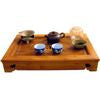
best made using the traditional Chinese method of tea-making known as Gong Fu Cha (Tea With Great Skill). This highly controlled method of tea-making is characterized by using small teapots and multiple brews with very short steeping times of just a few seconds. This intensifies the flavour of any tea and reduces the caffeine consumed compared to Western methods of tea-making. In Gong Fu Cha, the first brew is for washing the leaves and is poured away, so it is not consumed. This also has the effect of washing away much of the caffeine which is highly soluble in water.
To learn about tea-making using the traditional Chinese Gong Fu Cha (Tea With Great Skill) technique, read our guide Gong Fu Cha - The Complete Guide To Making Chinese Tea by Daniel Lui.
 Top of Page
Top of Page

Ask The Tea Wizard
Don't know which tea is right for you? Answer a few questions and the Online Wizard will show you all the Chinese teas that suit your taste.


